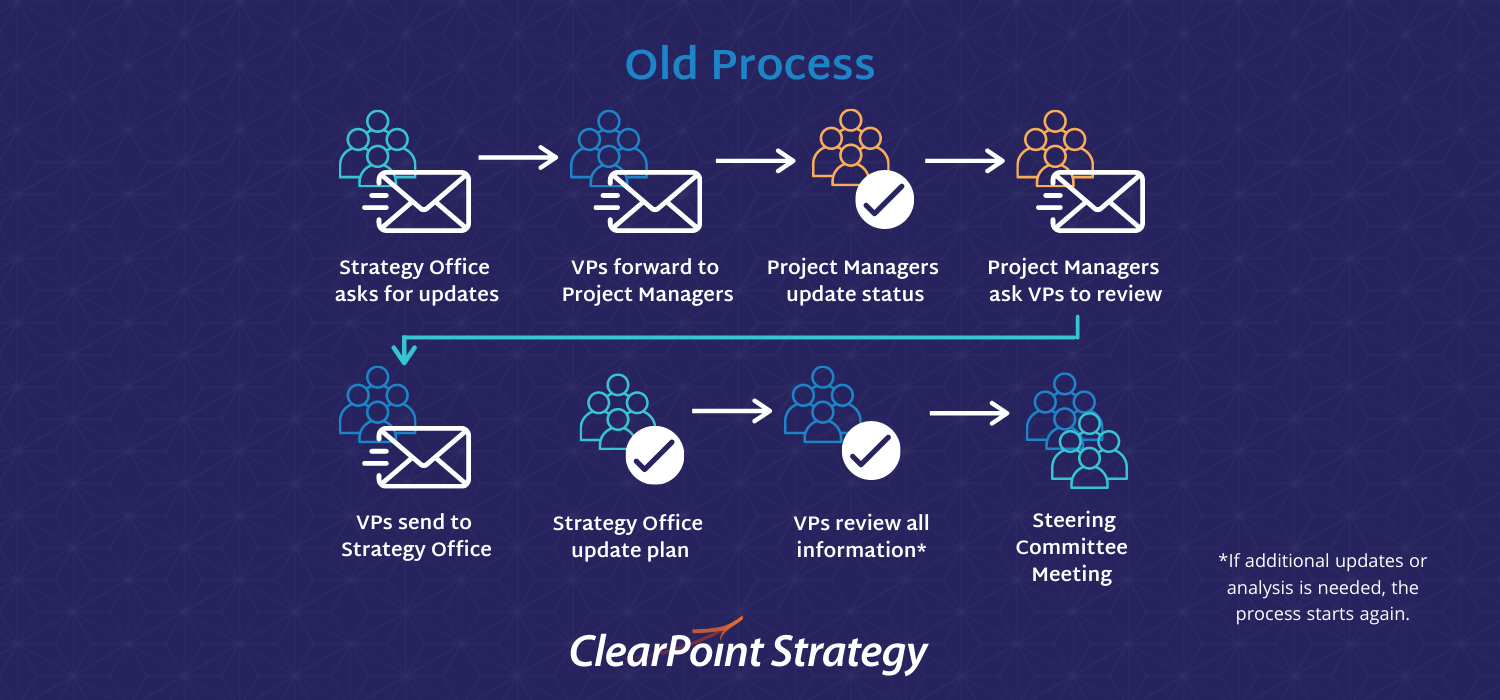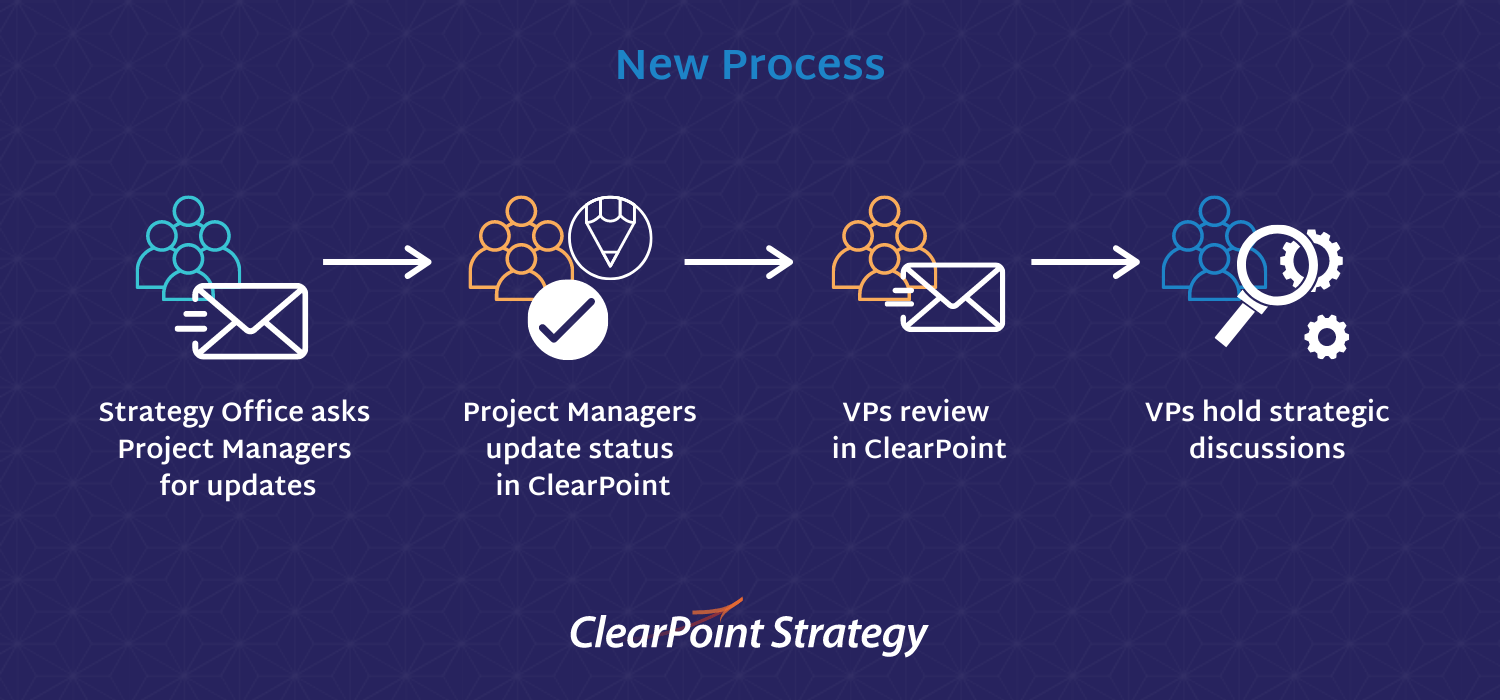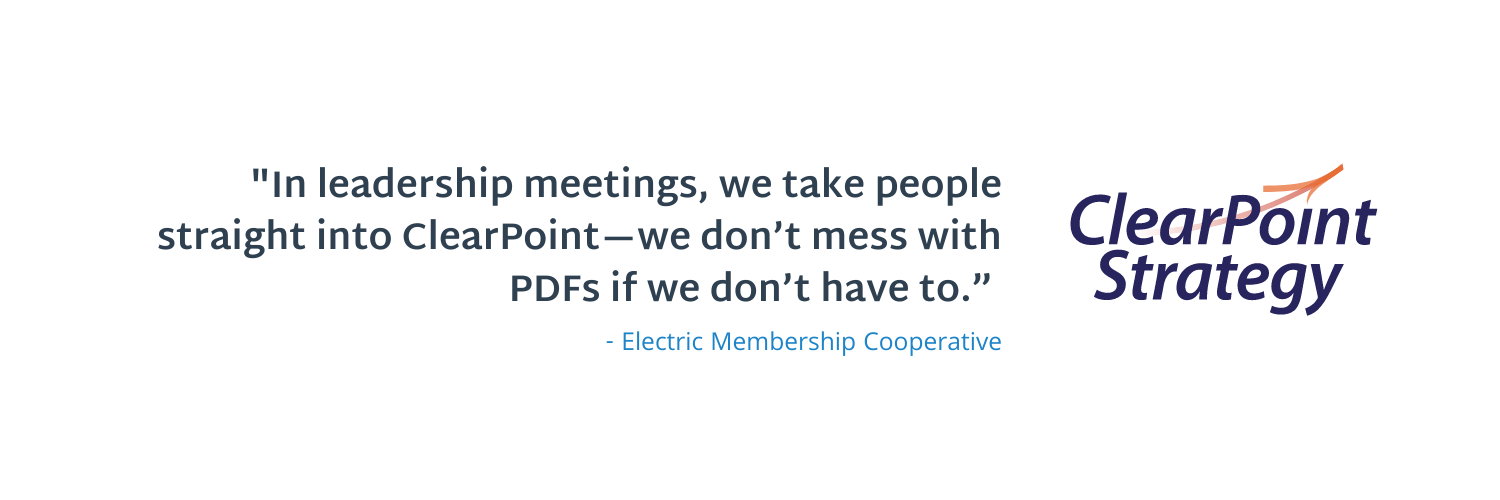Using ClearPoint For Project Management: A Case Study

One electricity cooperative cut the time it took for project reporting by 80%.

“Now people are more focused on what we have to do as a team... They’re part of the project management process instead of just being a team member.”
Using ClearPoint For Project Management: A Case Study
One ClearPoint customer, an electric cooperative, had wanted to develop its strategic planning process and hone its metric and project management tracking processes for years. This process involved numerous members of the organization’s workforce and took many hours to update. And each department was managing projects using different tools. The strategic planning team was tasked with solving this challenge, and that’s when they found ClearPoint. After putting our software solution to work, the time it took for their team to report on monthly initiatives decreased dramatically because the number of steps in the process was cut by 50%, allowing them to finalize updates in a week rather than the previous time frame of two or more weeks. ClearPoint also gave the entire leadership team greater visibility into the planning process, and helped the organization get employee buy-in on its strategy-related efforts.
Project Management Case Study Analysis: Electric Cooperative
An Electric Membership Cooperative is a private company whose purpose is to deliver reliable electricity to its members at the lowest price. For the purposes of this case study, we will refer to this specific organization as EMC, which provides power to nearly a quarter million homes and businesses in its local region. Member-owned and member-governed, the cooperative team is committed to providing the best, most reliable service among its competitors. Good management has always been one of its guiding principles—a fact that propelled its strategy office to work hard at developing and modernizing its strategic planning process.
Strategic Planning: A Need To Grow
The cooperative’s business intelligence analyst joined the now three-person team that makes up the strategic planning and analytics department just a couple of years ago. When he came on board, the VP of the department was already promoting strategic thinking to teams and individuals for years. But as the sole employee in the strategy office, she was limited in what she could accomplish without additional manpower and support tools.
Team members would describe the cooperative’s strategy process as, “employee-oriented. We start every year with strategic planning workshops, giving every department an opportunity to do a SWOT analysis and develop initiatives based on that." Those plans are then approved by the board and leadership team.
Eventually the strategy ideas began to catch on, but the strategy team’s reporting system was preventing real progress. At the beginning of every month, batches of emails were sent out to all the VPs, who acted as “sponsors” of projects within their domain. The VPs in turn would ask project managers for status updates. That information was then reported back to the strategy office through the various VPs.
All incoming data was tracked in a spreadsheet. “If the status of a project was red or yellow, we’d have to ask the VPs to reach back out to those people and ask for more details. Getting responses could take anywhere from one to two weeks. There were too many people involved, all of whom were just passing information around instead of diving into it and understanding how it plays into the bigger picture.”

There were also issues with version control. “The spreadsheet was a nightmare to keep up. We’d distribute a version that we thought contained current data, but inevitably we’d get an update and have to send it out again, asking people to ignore the previous version.” Once the strategy office had what they believed was the final data, they’d sort the spreadsheet, filter things out to accommodate different audiences, and make sure every PDF report was printed correctly.
Better Reporting Leads To Better Decision-making
Problems like these prompted the cooperative to invest in ClearPoint. Since then, the cooperative’s monthly reporting process is much simpler: Kicking things off on the first of every month, the strategy team alerts project managers to update the data relevant to their initiatives and provide an analysis for context. “It shouldn’t take anyone more than a few minutes to do it. And at that point, the reporting process, for them, is over—they’ve given us everything we need.”

Because VPs aren’t wasting time chasing down information anymore, they can take more of a management role, providing whatever resources necessary to help move projects along. If they have questions about progress, they can usually find that information right in the analysis field. “We still encourage discussion, but now it’s more solutions-focused rather than simply passing along information.” VPs can also now easily view projects specific to their domain, rather than sorting through a huge list, and take a deeper dive into any one area if necessary.
The simplicity of reporting has also eliminated the need for PDFs. “In leadership meetings, we take people straight into ClearPoint—we don’t mess with PDFs if we don’t have to.”

ClearPoint also makes it easy to see where they should focus attention during leadership meetings. “If a project is green, we trust things are going well. We’re essentially looking for red and yellow initiatives. We want to focus on getting resources to those teams that are behind and understanding what the problems are.”
The strategy team also uses the Gantt charts within ClearPoint for long-term planning of initiatives. They can see how many are scheduled in certain parts of the year, or this year versus next year, and whether or not they’re overloaded by the current schedule. “It’s a good visual planning tool. We couldn’t sort things easily before, manipulating reports to exclude certain projects or include just one level of the organization, for example.”
The ability to look at projects in context with one another and on various levels is important to the strategy team. “We talk about prioritization all the time in our strategic planning process—we preach it but haven’t always practiced it. We have departmental strategic planning workshops that generate a lot of great ideas, but sometimes there are too many. Doing them all could overwhelm people and create burnout.” Having this level of insight into projects makes it easier for the team to identify potential issues, as well as make decisions around what can wait and what can’t. “We can better schedule and plan, whether it’s just for the upcoming year or over a three- to five-year period.”
Upping Their Strategy Game With Organizational KPIs
Before ClearPoint, the difficulty involved in tracking departmental projects was a clear limitation, both in terms of project management and strategy execution. But there was something else the cooperative’s strategy team knew it wanted to tackle: creating and tracking KPIs on an organizational level. They knew they didn’t have the right tool (or the right people, before the team was fully built out) to pull it off, but it was clearly the missing piece needed to get them where they wanted to go.
With a new, seamless reporting process and some guidance from ClearPoint’s strategy experts, the cooperative expanded its use of strategy maps, organizational objectives, and KPIs.
“We’d never really worked with KPIs before and, in the years before ClearPoint, we’d tried to set the foundation for them. But we didn’t have the right tool to support the effort. Some teams took it upon themselves to create a spreadsheet and tried to track measures on their own, which was impressive!”
KPI tracking was such an important concept that the strategy team knew they wanted to launch it in a meaningful way. Joseph, the Director of Customer Success at ClearPoint, helped them think through their ideas. “We were shooting from the hip—we had some weird ideas about KPIs and how best to organize them and build out dashboards. Joseph ran with some of our crazy ideas and helped us make it all a reality.” Now, KPI owners update their numbers in ClearPoint once a month, and leaders conduct a KPI review at the end of every month. Again focusing primarily on KPIs with red and yellow statuses, discussions center around what needs to be done to reach the goals.
“KPIs are the future for us. We have a tool and everyone is tracking them now. And we’re currently working with the VPs and executives to review everything we have inside ClearPoint from a KPI perspective, to make sure we’re tracking the right things and that we’ve set the right targets for them in terms of performance. It’s going to be a huge undertaking, but it will take us to a whole new level from a performance perspective. We’re really excited about that.”
Everyone Is A Strategy Partner
The use of ClearPoint has also increased employee buy-in when it comes to strategy and performance. Prior to implementation, new initiatives were chartered by the project team in a Word document that was essentially viewed once and then forgotten. Now, the cooperative uses ClearPoint to define initiatives—their scope, high-level requirements, and milestones and track them all in one place. Doing so has engaged all project team members in the process of building out milestones, and helped people get familiar with ClearPoint. People know their team is going to track a project there, and they may even be named as owners of some element of a project. “It gives a sense of ownership to everyone because of the easy availability of the data. Now people are part of the project management process instead of just being a team member.
“Anyone can access their department’s dashboards, see their strategic plan, KPIs, and initiatives. They can even see what departments on the opposite side of the organization are working on. We’ve taken on so much over the last few years from a strategic planning process perspective. We’re trying to help employees understand the larger strategy of the organization and how it applies to them. We hope to create better buy-in as a result. We certainly won’t force employees outside of the update process to go into ClearPoint unless they want to, but we want to make sure that information is available so they can see the strategy and how they’re playing a role.”
Want to see more examples of successful project management using ClearPoint? Take a look at our other customer stories.


.webp)
.webp)
.webp)
.webp)
.webp)
.webp)
.webp)
.webp)
.webp)
.webp)








.webp)

